Discover B.Tech AKTU Quantum Book Short Questions Notes on Application of Soft Computing. Unravel the power of fuzzy logic, neural networks, and genetic algorithms for intelligent problem-solving and optimization.
Dudes 🤔.. You want more useful details regarding this subject. Please keep in mind this as well. Important Questions For Application of Soft Computing: *Quantum *B.tech-Syllabus *Circulars *B.tech AKTU RESULT * Btech 3rd Year * Aktu Solved Question Paper
Unit-I Neural Network-I (Introduction and Architecture)
Q1. What are neurons ?
Ans. A neuron is a tiny cell that receives electrochemical signals from several sources and responds by transmitting electrical impulses to other neurons.
Q2. What is soft computing ?
Ans. Soft computing is a set of computational techniques used in computer science, machine learning, and some engineering fields to explore, simulate, and analyze extremely complicated phenomena.
Q3. Give the difference between supervised and unsupervised learning in artifñcial neural network.
Ans.
| S. No. | Supervised learning | Unsupervised learning |
| 1. | It uses known and labeled data as input. | It uses unknown data as input. |
| 2. | It uses offline analysis. | It uses real time analysis of data. |
| 3. | Number of classes are known. | Number of classes are not known. |
| 4. | Accurate and reliable results | Moderate accurate and reliable results. |
Q4. Define activation function.
Ans. The essential component of a neural model is an activation function. It is used to limit the amplitude of a neuron’s output. It is also known as the squashing function.
Q5. Give types of activation function.
OR
What are the different activation functions ? Explain.
Ans. Types of activation function:
i. Signum function ii. Sigmoidal function
iii. Identity function iv. Binary step function
v. Bipolar step function
Q6. Give advantages of neural network.
Ans. Advantages of neural network:
- i. A neural network is capable of tasks that a linear programme is incapable of performing.
- ii. It is applicable to any application.
A neural network learns and does not require reprogramming.
Q7. What are disadvantages of neural network (NN) ?
Ans. Disadvantages of neural network :
i. The neural network needs training to operate
ii. It requires high processing time for large NN.
Q8. List the various types of soft computing techniques and mention some application areas for neural network.
Ans. Types of soft computing techniques:
- 1. Fuzzy logic control
- 2. Neural network
- 3. Genetic algorithms
- 4. Support vector machine
Application areas for neural network:
- 1. Speech recognition
- 2. Character recognition
- 3. Signature verification application
- 4. Human face recognition
Q9. Draw a biological NN and explain the parts.
Ans.
- i. Biological neural networks are constructed using real biological neurons that are linked in the peripheral nervous system.
- ii. A biological neural network, in general, is made up of a set of chemically coupled or functionally interconnected neurons.



A biological neural network has three major parts
- 1. Soma or cell body: It houses the cell’s nucleus as well as other important components known as organelles, which conduct specialized functions.
- 2. A set of dendrites: It spreads out from the cell in the form of a tree-like structure. The neuron receives its electrical signal via these dendrites.
- 3. Axon: It is a tabular extension of the cell (Soma) that transports an electrical signal from Soma to another neuron for processing.
Q10. What is single layer feed forward network ?
Ans. The simplest type of layered network is a single layer feed forward network, which has an input layer of source nodes that projects onto an output layer of neurons but not vice versa.
Q11. Write different applications of neural networks (NN).
Ans. Application of NN are:
1. Image recognition 2. Data mining
3. Machine translation 4. Spell checking
5. Stock and sport bet prediction 6. Statistical modeling
Q12. Draw an artificial neural network.
Ans. An Artificial Neuron Network (ANN) is a computational model based on the structure and functions of biological neural networks.
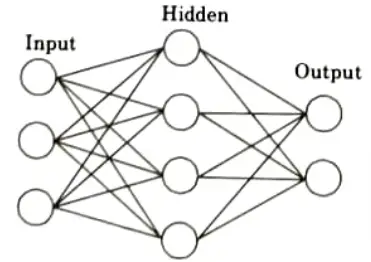


Q13. Give types of associative memory.
Ans. There are two types of associative memory:
- i. Auto-associative memory
- ii. Hetero-associative memory
Q14. Compare soft computing vs. hard computing.
OR
How soft computing is different from conventional computing ?
Ans.
| S. No. | Soft computing | Hard (Conventional) computing |
| 1. | Soft computing is liberal of imprecision, uncertainty, partial truth and approximation. | Hard computing requires a precisely state analytic model. |
| 2. | Soft computing is based on fuzzy logic, neural set, and probabilistic reasoning. | Hard computing is based on binary logic, crisp system, numerical analysis and crisp software. |
| 3. | Soft computing will emerge its own programs. | Hard computing requires programs to be written. |
Q15. Define supervised and unsupervised learning in artificial neural network.
Ans. 1. Supervised learning:
- i. Learning is done with the assistance of a trainer.
- ii. In ANN, each input vector must be accompanied with a target vector that reflects the desired output. The output vector is the result of the input vector.
2. Unsupervised learning:
- i. Learning is done without the assistance of a trainer.
- ii. During the training process, the network accepts input patterns and arranges them into clusters. There is no feedback in the environment to explain what the outcome should be or whether it is applied correctly.
Q16. What do you mean by neural network architecture ?
Ans. The arrangement of neurons into layers, as well as the connection patterns between layers, activation functions, and learning methods, are referred to as neural network architecture. A neural network’s model and design dictate how a network translates its input into an output.
Q17. Name some application of competitive learning network.
Ans. Applications of competitive learning networks:
- 1. Vector quantization
- 2. Analyze raw data
- 3. Image browsing systems
- 4. Medical diagnosis (visualization of data)
- 5. Speech recognition
- 6. Data compression
- 7. Feature extraction
Q18. Artificial Intelligence can be used in Neural Network or not. Justify your answer.
Ans. We may employ artificial intelligence in neural networks because we can combine the desirable qualities of adaptivity, robustness, and uniformity provided by neural networks with the representation, inference, and universality provided by symbolic artificial networks.
Q19. What is reinforcement learning ?
Ans. Reinforcement learning is a sort of dynamic programming that uses a reward and punishment system to train algorithms. To attain a goal in an uncertain, potentially complex environment, the agent learns through interacting with its surroundings.
Q20. What are the various learning rules ? Explain.
Ans. Different learning rules in the neural network:
- 1. Hebbian learning rule: It identifies how to modify the weights of nodes of a network.
- 2. Perceptron learning rule: Network starts its learning by assigning a random value to each weight.
- 3. Delta learning rule: Modification in weight of a node is equal to the multiplication of error and the input.
- 4. Correlation learning rule: The correlation rule is the supervised learning.
- 5. Outstar learning rule: We can use it when nodes or neurons in a network are arranged in a layer.
Q21. What do you mean hetero-associative memory ?
Ans.
- 1. The retrieved pattern in a hetero-associative memory differs from the input pattern not only in content but also in kind and format.
- 2. The training input and target output vectors differ in hetero-associative memory.
Q22. Why sigmoid function is so important activation function in neural network ?
Ans. A sigmoid function accepts any real integer and produces a value between 0 and 1. As a result, it is particularly useful for models that require us to anticipate the probability as an output. Because the probability of anything occurs only between 0 and 1, the sigmoid function is fundamental in neural networks.
Q23. Whether the Hebbian learning rule is an example of unsupervised learning or not, justify your answer ?
Ans.
- 1. According to the Hebbian learning rule, if two neighbour neurons are stimulated and deactivated simultaneously, the weight connecting these neurons should grow.
- 2. The weight of neurons acting in opposite phases should decrease. The weight should not change if there is no signal connection.
- 3. Neuronal response is not taken into account. This is the unsupervised learning rule since intended neuron responses are not used in the learning operation. Hebbian learning rule is thus an example of unsupervised learning.
Q24. Consider an auto associative net with the bipolar step function as the activation function and weights set by Hebb rule (outer diagonal) where the main diagonal of the weight matrix is set to zero. Find the weight matrix to store the vector v1= (1 1 1 1 – 1 – 1).
Ans. The vectors v, is stored with weight matrix
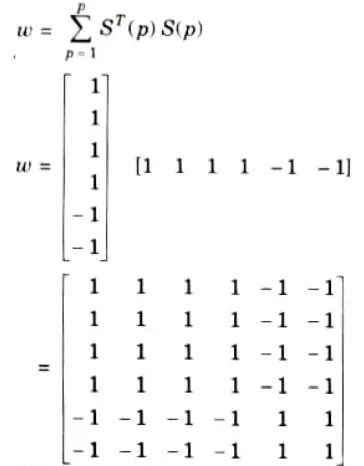


Setting diagonal to zero we have
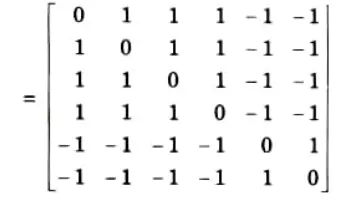


Q25. Use the Hebb rule to store the vector (1 1 – 1 – 1) in an auto associative neural network. Find the weight matrix.
Ans. By using Hebb rule, the stored vector with weight matrix is,
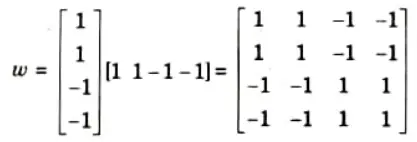


Q26. Use the Hebb rule to store the vector [1 1 1 – 1] in an auto-associative neural network.
Ans. The vector s is stored with the weight matrix as :
![Use the Hebb rule to store the vector [1 1 1 - 1] in an auto-associative neural network.](https://bachelorexam.com/wp-content/uploads/2023/07/image-1412.png)
![Use the Hebb rule to store the vector [1 1 1 - 1] in an auto-associative neural network.](https://bachelorexam.com/wp-content/uploads/2023/07/image-1412.png)
![Use the Hebb rule to store the vector [1 1 1 - 1] in an auto-associative neural network.](https://bachelorexam.com/wp-content/uploads/2023/07/image-1412.png)
![Use the Hebb rule to store the vector [1 1 1 - 1] in an auto-associative neural network.](https://bachelorexam.com/wp-content/uploads/2023/07/image-1411.png)
![Use the Hebb rule to store the vector [1 1 1 - 1] in an auto-associative neural network.](https://bachelorexam.com/wp-content/uploads/2023/07/image-1411.png)
![Use the Hebb rule to store the vector [1 1 1 - 1] in an auto-associative neural network.](https://bachelorexam.com/wp-content/uploads/2023/07/image-1411.png)
Q27. Name any three commercial software used for soft computing techniques.
Ans. Three commercial software used for soft computing techniques are:
1. Open CV 2. MATLAB 3. LabVIEW
Q28. What is leaky learning ?
Ans. Leaky learning is a competitive learning algorithm variant in which all weights must learn on each time step rather than only the winning weight.
Q29. Which neural network architecture is used for online spell checking?
Ans. Personalized Error Correction using Neural Network (PENN) is used for online spell checking.
Q30. What is difference between autoassociative memory and heteroassociative memory?
Ans.
| S. No. | Autoassociative Memory | Heteroassociative Memory |
| 1. | In autoassociative memory, the associated pattern pair (x, y) is same. | In heteroassociative memory, the associated pattern pair (x, y) is different. |
| 2. | In this model, given a distorted or a partial input pattern x as input, the whole pattern with perfect form y is recalled as output. | This model recalls output y on a given input x or vice-versa. |
| 3. | Useful for image refinement. | Useful for the association of patterns. |
Unit-II Neural Network-II (Back Propagation Network)
Q1. Give characteristics of multilayer perceptron.
Ans. Characteristics of multilayer perceptron:
- i. In this model, each neuron in the network has a non-linear activation function.
- ii. The network contains hidden neurons that do not contribute to the network’s input or output.
- iii. The network has a high degree of connectedness.
Q2. Give the name of the tuning parameters of back propagation neural network.
Ans. Tuning parameters of back propagation neural network are:
i. Momentum factor ii. Learning coefficient
iii. Sigmoidal gain iv. Threshold value
Q3. What do you mean by momentum factor ?
Ans. The step size of change in weights or biases is determined by the momentum factor. When the momentum component is 0, the smoothing is minimal, and the entire weight adjustment is based on the newly calculated change. If there is only one, the new adjustment is ignored and the prior one is repeated.
Q4. Give applications of back propagation network.
Ans. Applications of back propagation networks are:
- i. Optical character recognition.
- ii. Non-linear simulation.
- iii. Data compression.
Q5. Define ADALINE network.
Ans. The adaptive linear neural element network makes use of supervised learning. In this, there is only one output neuron and the output values are bipolar (-1 or + 1).
Q6. Write a short note on MADALINE network.
Ans. A MADALINE (many ADALINE) network is created by combining a number of ADALINES. The use of multiple ADALINES helps counter the problem of non-linear separability. In this, each ADALINE unit receives the input bits x1, x2 and the bias input x0 = 1 as its inputs.
Q7. If the net input to an output neuron is 0.64, calculate its output when the activation function is binary sigmoidal.
Ans. For binary sigmoidal,
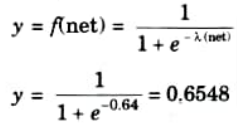


Unit-III Fuzzy Logic-I (Introduction)
Q1. What is the difference between crisp set and fuzzy set ?
Ans.
| S. No. | Crisp set | Fuzzy set |
| 1. | In crisp set, an element either belongs to or does not belong to a set. | Fuzzy sets support a flexible sense of membership of elements to a set. |
| 2. | Membership value in crisp set is 0 and 1. | Membership value in fuzzy set is in between 0 and 1. |
Q2. Define a fuzzy Cartesian product.
Ans.



Q3. What are the different fuzzy relation operations ?
Ans. Different fuzzy relation operations:
- 1. Union
- 2. Intersection
- 3. Complement
- 4. Composition
Q4. Give the industrial applications of fuzzy logic.
Ans. Industrial applications of fuzzy logic:
- 1. Aerospace
- 2. Automotive
- 3. Defence
- 4. Finance
- 5. Medical
Q5. What is set ?
Ans. A set is a well defined collection of objects. A set in certain contexts may be associated with its universal set from which it is derived.
For example:
A = {x|x is an odd number}
Q6. What do you mean by superset ?
Ans. Given sets A and B on E the universal set, A is said to be a superset of B if every element of B is contained in A. It is denoted as A ⊃ B.
Q7. Give operations on crisp sets.
Ans. Operation on crisp sets are:
i. Union (◠) ii. Intersection (◠)
iii. Complement (c) iv. Difference (-)
Q8. List down properties of crisp set.
Ans. Properties of crisp set are:
i. Commutativity ii. Associativity
iii. Distributivity iv. Idempotence
v. Identity vi. Law of absorption
vii. Law of excluded middle viii. Law of contradiction
Q9. Define covering.
Ans. A covering on A is defined as a set of non-empty subsets A that when combined provide the original set A. The non-empty subsets do not have to be disjoint.
Q10. Give properties of fuzzy sets.
Ans. Properties of fuzzy sets are:
i. Commutativity ii. Associativity
iii. Distributivity iv. Idempotence
v. Identity vi. Transitivity
vii. Involution viii. De Morgan’s law
Q11. Write a short note on partition.
Ans. A partition on A is defined to be a set of non-empty subsets A each of which is pairwise disjoint and whose union yields the original set A. Partition on A indicated as ПA).
Unit-IV Fuzzy Logic-II (Fuzzy Membership, Rules)
Q1. What are the disadvantages of fuzzy systems ?
Ans. Disadvantages of fuzzy system:
- 1. Fuzzy systems lack the ability to perform machine learning as well as neural network-type pattern identification.
- 2. To define fuzzy rules, expert input or instructions are required.
- 3. If the system has a large number of fuzzy rules, the process of tweaking the system parameters takes a relatively long time.
Q2. Define the fuzzy inference.
Ans. Fuzzy inference is the process of applying fuzzy logic to create a mapping from a given input to an output. It is a map that serves as a foundation for decision-making. Automatic control, data classification, decision analysis, expert systems, and computer vision have all seen success using fuzzy inference systems.
Q3. What is FLC?
Ans. A Fuzzy Logic Controller (PLC) is a rule-based system for fuzzy structure optimisation that incorporates the flexibility of human decision-making. It is a control law described by an IF-based knowledge-based system. THEN rules with ambiguous predicates and a fuzzy logic inference mechanism are applied.
Q4. Give the industrial applications of fuzzy logic.
Ans. Industrial applications of fuzzy logic:
- 1. Aerospace
- 2. Automotive
- 3. Defence
- 4. Finance
- 5. Medical
Q5. Draw fuzzy membership function to describe cold, warm and hot water.
Ans.



- 1. Fig. illustrates the membership functions, and shows the degree of particular temperature, is either cold, warm or hot.
- 2. The meaning of the expressions cold, warm, and hot is represented by functions mapping a temperature scale.
- 3. A point on that scale, where the vertical line is drawn, has three memberships.
- 4. The vertical line in the image represents a particular temperature that is too cold, warm and not hot.
- 5. Since the ‘hot’ function is at 0, this temperature may be interpreted as ‘not hot’.
- 6. The value of warm function is about 0.2, so it may be described by ‘slightly warm’, and the cold function is about 0.8, indicating it is fairly cold.
Q6. Give features of membership functions.
Ans. Features of membership function are:
- i. Core
- ii. Support
- iii. Boundary
Q7. What is support ?
Ans. If the region of universe is characterized by non-zero membership in the set Ā, then this defined the support of a membership function. The support has the elements whose membership is greater than 0.
Q8. Explain boundary.
Ans. If the region of universe has a. non-zero membership, then this defines the boundary of the membership for fuzzy set Ā. The boundary has the elements whose membership is between 0 and 1.
Q9. Mention connectives in crisp logic.
Ans. Connectives in crisp logic are:
- i. And
- ii. Or
- iii. Not
- iv. Implication
- v. Equality
Q10. Give connectives in fuzzy logic.
Ans. Connectives in fuzzy logic are:
- i. Negation
- ii. Disjunction
- iii. Conjunction
- iv. Implication
Q11. List the methods used for defuzzification.
Ans. Methods used for defuzzification are:
- i. Centroid method
- ii. Centre of sums (COS) method
- iii. Mean of maxima (MOM) defuzzification
Q12. Give two applications of fuzzy systems.
Ans. Two application of fuzzy system are:
- i. Greg Viot’s fuzzy cruise control system
- ii. Yamakawa’s air conditioner controller
Q13. What is the significance of fuzzy quantifier ?
Ans. Significance of fuzzy quantifier: It provide an approximate idea of the number of elements in a subset fulfilling a certain condition.
Unit-V Genetic Algorithm (GA)
Q1. Define genetic algorithm and write down the advantages of GA.
OR
What are the advantages of GA over conventional algorithms?
Ans. Genetic algorithms are search and optimisation algorithms that are based on the mechanics of natural genetics and natural selection. GA transforms design space into genomic space.
Advantages of GA:
- 1. Easy to understand.
- 2. Supports multi-objective optimization.
- 3. Good for noisy environment.
- 4. Inherently parallel and easily distributed.
Q2. Define mutation.
Ans. Mutation is the process of producing a changed generation by performing a random distortion of the string after crossover.
Q3. What is simulated annealing ?
Ans. Simulated Annealing (SA) is a powerful and versatile optimisation technique. It is useful for locating global optima in the presence of many local optima. The term “annealing” relates to a thermodynamic analogy, specifically the way metals cool and anneal. Instead of a material’s energy, simulated annealing employs the objective function of an optimisation problem.
Q4. Describe in brief tree encoding in GA.
Ans. Tree encoding is used in genetic programming to evolve programmes or expressions. Every chromosome in tree encoding is a tree of some objects, such as functions or commands in a computer language.
Q5. Explain binary encoding in genetic algorithm.
Ans. Binary encoding:
- i. Binary encoding is the most commonly used method of genetic representation because GA uses binary encoding.
- ii. In binary encoding, every chromosome is a string of bits, 0 or 1.
For example:
Chromosome A101100101100101011100101
- iii. Binary encoding gives many possible chromosomes.
Q6. What is inheritance in genetic algorithm ?
Ans. In a genetic algorithm, inheritance refers to the process of producing offspring who compete for survival to form the next generation of the population. Reproduction, crossover, mutation, inversion, segregation, and other genetic inheritance operators are examples.
Q7. List down various types of encoding of genetic algorithm.
Ans. Various types of encoding of GA are:
- i. Binary encoding
- ii. Octal encoding (0-7)
- iii. Hexadecimal encoding (0123456789 ABCDEF)
- iv. Permutation encoding
- v. Value encoding
- vi. Tree encoding
Q8. What are the basic operators of genetic algorithm ?
Ans. Basic operators of genetic algorithm are:
- i. Selection or Reproduction
- ii. Mutation
- iii. Crossover
Q9. Give various selection methods in GA.
Ans. Various selection methods are:
- i. Roulette-wheel selection
- ii. Boltzmann selection
- iii. Tournament selection
- iv. Steady-state selection
- v. Rank selection
Q10. Define genetic algorithm.
Ans. Genetic algorithms are search and optimisation algorithms that are based on the mechanics of natural genetics and natural selection. These algorithms develop search and optimisation procedures based on the principles of natural genetics and natural selection. GA transforms design space into genomic space.
Q11. Give some aspects of genetic algorithm.
Ans. Three most important aspects of genetic algorithm are:
- i. Definition of objective function.
- ii Definition and implementation of genetic representation.
- iii. Definition and implementation of genetic operators.
Q12. What is reproduction ?
Ans. The first population operator is reproduction or selection. Chromosomes are chosen from the population to be parents in order for them to cross and form a new population.
Q13. What do you mean by crossover operator?
Ans. To make a better string, the crossover operator was applied to the mating pool. It searches a parameter space in such a way that the information held in the current string is retained as much as possible. It is of three types:
- i. Single-site crossover
- ii. Two-point crossover
- iii. Multi-point crossover
Q14. What do you mean by convergence of GA ?
Ans. When there is no significant improvement in the fitness values of the population from one generation to the next, a Genetic Algorithm (GA) is said to be converged. Because every member in the population is identical, it brings evolution to a halt. With genetic algorithms that use crossover, full convergence may be observed.



Important Question with solutions | AKTU Quantums | Syllabus | Short Questions
Application of Soft Computing Btech Quantum PDF, Syllabus, Important Questions
| Label | Link |
|---|---|
| Subject Syllabus | Syllabus |
| Short Questions | Short-question |
| Question paper – 2021-22 | 2021-22 |
Application of Soft Computing Quantum PDF | AKTU Quantum PDF:
| Quantum Series | Links |
| Quantum -2022-23 | 2022-23 |
AKTU Important Links | Btech Syllabus
| Link Name | Links |
|---|---|
| Btech AKTU Circulars | Links |
| Btech AKTU Syllabus | Links |
| Btech AKTU Student Dashboard | Student Dashboard |
| AKTU RESULT (One VIew) | Student Result |
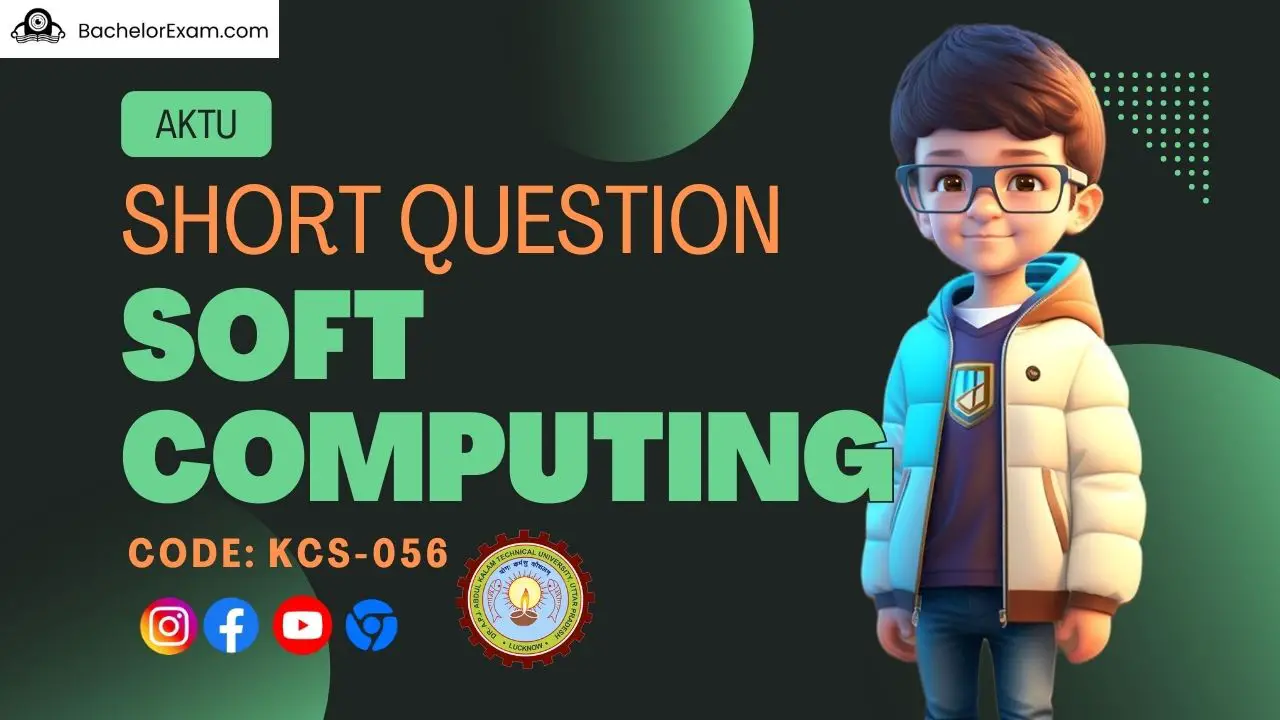
4 thoughts on “Btech Application of Soft Computing Aktu Short Question KCS-056”